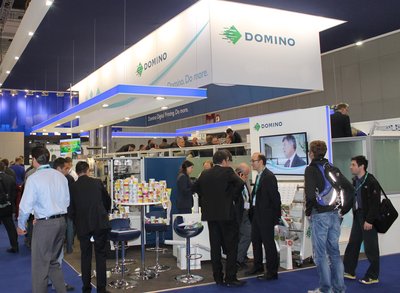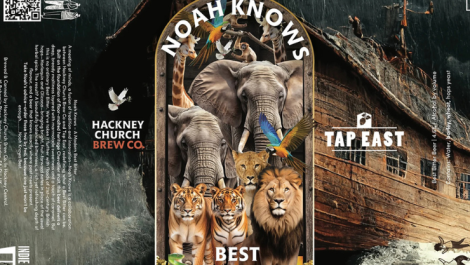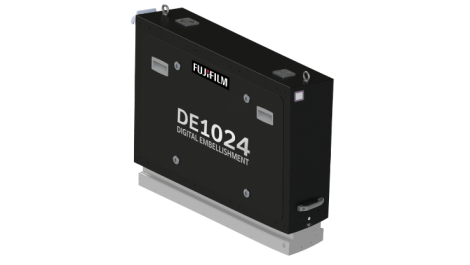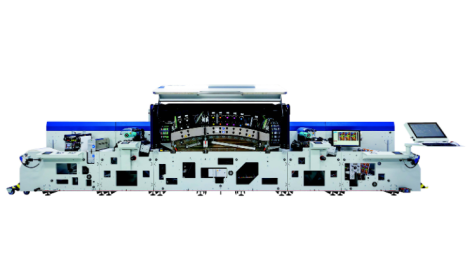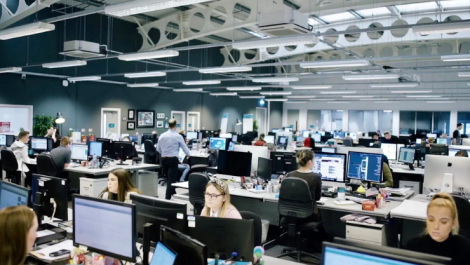Domino launched the N610i at Labelexpo in Brussels
Labelexpo 2013 will be remembered as the year that inkjet came of age. From small desktop printers to fully fledged narrow web production presses, the technology was everywhere. The newly created Inkjet Trail took visitors through the halls to visit some of the suppliers, but there was so much more to see, as Sean Smyth reports.
The inkjet trail proved to be a very popular feature of Labelexpo in Brussels. Six press suppliers took part, with the same files printed on their machines using the same substrates for food, pharmaceutical and industrial labels. Durst, Domino, EFI, Epson, Heidelberg Linoprint and SPG (Stork Prints) took part, with pre-press and die-cutting files prepared by Esko, while UPM Raflatac, FLEXcon and Herma supplied common paper, film and foil. Xeikon also took part, providing an electrophotographic alternative. And the winner was . . . indeterminate, actually. There was some discussion about the conditions favouring one or other machine, some barcodes were over white but generally results looked good, albeit with different gloss levels, coating and lamination.
There were low end modified desktop printers, specialist low end web machines (several using memjet pagewide heads), then the heavy duty narrow web presses, several of which now feature laser-cutting as an integral option. UV inks dominated and there were interesting ink announcements from Agfa, Fujifilm and SunJet. Aqueous inks are growing, Epson being joined by high end presses from Delphax and Miyakoshi, while Epson debuted its first UV model. Rumours abounded about a new digital press from Mark Andy shown behind closed doors. Despite the company’s protestations, the announcement about a new Digital Series was made a month later.
Inkjet, inkjet, inkjet
Throughout the show, inkjet technology made its presence known. There were low end modified desktop printers, specialist low end web machines (several using memjet page-wide heads), then the heavy duty narrow web presses, several of which now feature laser cutting as an integral option. UV inks dominated and there were interesting ink announcements from Agfa, Fujifilm and SunJet. Aqueous inks are growing, Epson being joined by high end presses from Delphax and Miyakoshi, while Epson debuted its first UV model. Rumours abounded about a new digital press from Mark Andy being shown behind closed doors, and despite the company’s protestations, the announcement about its Digital Series was made a month later.
So, in strict alphabetical order:
ALS Engineering GmbH Ecojet UV printer is a modular design with print widths from 280-630 mm and speeds from 12-50 m/min in up to seven colours. The Ecojet uses Xaar 1001 printheads, as doesAtlantic Zeiserwhich showed its Digiline Booklet line. The latter is aimed at pharmaceutical companies needing booklet labels for clinical trials, usually in high volume as part of the development for new drugs and treatments. It can personalise thick booklets (up to 4 mm) onto paper and film while guaranteeing precise print positioning even for misaligned labels on the carrier and there is an optional 100% camera inspection. Label booklets are growing across Europe as multi-language versions are increasingly demanded and a single label is often not large enough.
Dainippon Screen made the commercial launch of the Truepress Jet L350UV narrow web machine, which is also being sold by Dantex in 10 European countries including the UK, and in Turkey. Screen emphasises its experience in inkjet and in packaging, and has high hopes for the new press. It uses Kyocera heads with Screen’s colour management and screening technology, linked to its proprietary ink, formulated to provide high quality with a thin ink film. The first machines will be four colour and white should be available early next year. The press will run at 50 m/min with a maximum print width of 322 mm and will be supplied with the Equios workflow with certified barcode capability.
Delphax announced it has now sold four of the high-speed Colordyne presses that use memjet printheads. It displayed a full converting line with Aztek finishing, with an optional laser finishing system from US specialist LasX in a full converting line.
Domino has started to ramp up its installations of the N600i machine, and launched an upgrade in the new N610i model at the show. This features several improvements over the previous version, with better web control and a new optional white. It operates at speeds of up to 75 m/min with a 600 dpi native resolution. To maximise the high opacity, the company is using two printbars for white and printing at 50 m/m. Inline finishing equipment from AB Graphics was also on stand.
Durst launched its first narrow web Tau press in 2009 for labels and reported 13 sales in the first half of 2013 bringing the total to 40 installs, with a target of 50 early in 2014. There were several models on show, including a full conversion line with a 330 mm wide six colour plus white model, with an integrated laser cutter. It is selling a new set of low migration inks from SunJet that conforms to the Swiss Ordnance and was shown printing foil lids and flexible packaging as well as labels. There is an integrated chill roller to control the temperature of printed films and foils during curing.
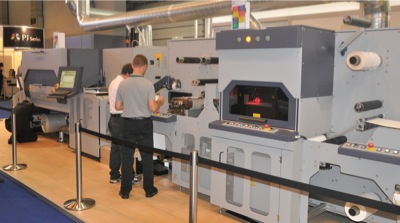 Durst Tau330 with inline laser finishing
Durst Tau330 with inline laser finishing
EFI is the leader in terms of inkjet press installations, reporting significant growth in its ink sales into labels in 2013. It has broadened its label offering, unveiling the new Jetrion 4950LX at the show. This has doubled the number of heads inline, allowing for either higher resolution at 720 dpi, or faster throughput, and features full LED curing enabling heat sensitive and thermally sensitive materials to be printed. There were new finishing modules for the Jetrion 4900, a new varnish/lamination module and a new high-power laser cutter for the 330 mm maximum width format. The latest integrated laser is available in single (500W) or dual-head (1000W) configuration to provide higher speed at widths of 330 mm. EFI is a company actively pushing the analogue to digital transformation, spending $130 million on R&D in 2012. It has opened a new demo centre in Brussels, to better serve its small business customer base.
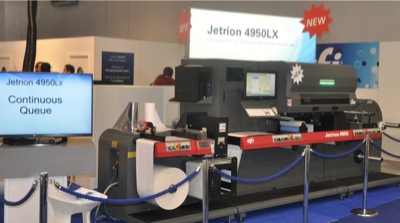 The new Jetrion 4950LX from EFI
The new Jetrion 4950LX from EFI
Epson launched the fixed head UV label press, the SurePress L-6034VW, which is available in two models, CMYK with digital varnish and high opacity white ink (the L-6034VW) and without white ink (the L-6034V). It is very different to the established L-4033 that uses water-based ink with a traversing head that prints on substrate held under vacuum on a printing table. The new design features a central drum that holds the stock under the heads at 15 m/min up to 330 mm width allowing thin stocks to be printed. There is LED for pinning and curing, and final cure. It features a nozzle system analysis that determines if nozzles malfunction, with feedback to make sure it reverts to the ground state. The heads are a new generation of thin-film piezo models, called PrecisionCore, where new very thin piezo material allows Epson to increase nozzle density, these heads are made at the new factory that Epson has spent €125 million to build. The company is reporting sales of its label presses accelerating after an initial slow take-up.
 Epson’s new L6034VW is available in two versions, with or without white
Epson’s new L6034VW is available in two versions, with or without white
FFEI showed the new Graphium on the Fujifilm stand. The second generation machine offers several advantages over the previous Caslon machine, and FFEI has already sold five Graphiums at Print13 in Chicago. Not all were to specialist converters; one customer was a large internet retailer which spent a lot on buying in labels. The company sees many opportunities opening in new areas and the link with Fujifilm, which is providing the inks and selling the system, looks to be an excellent one for both parties.
Focus Label Machinery showed the d-Flex digital inkjet system, which features an inkjet module from IIJ with Konica Minolta heads as an option to add to flexo presses, or run into finishing as wanted.
Swiss developer Graficon Maschinenbau showed the inkjet Puma iT module for its T200 model, for inline printing, die-cutting and finishing multi-coloured labels to a high standard. This is an upgrade option, existing T180/200 printing-machines can be converted into a four colour digital press (CMYK) and with white as an extra colour option.
Hapa had the Universal LP 834 reel to reel press on show, while interestingly the Heidelberg Linoprint L print and finish system was being shown on the Gallus stand, a firm indication of the growing importance of digital for the flexo leader.
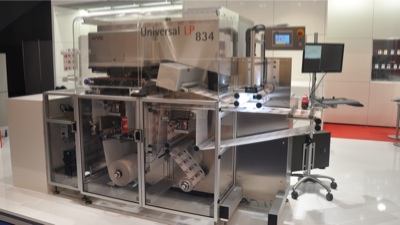 Hapa Universal LP 834
Hapa Universal LP 834
IIJ had its inkjet components on show, including direct-to-pack developments, while theINXSystec NW140 was on the Spartanics stand, inline with its laser cutting system.
ITE showed the Rapid Label equipment using memjet technology with a new LED dry toner printer, the ComPress LP4. It has broadened the digital finishing options, with the compact Eclipse LF3 laminator/digital cutter on display with its big brother, the Rapid D2 laminator/semi-rotary cutter.
JF Machinery had the four colour PicoColour 140, a very narrow Xaar powered low cost roll-to-roll UV cured system, which is available in 70, 140 or 210 mm print width, and prints at speeds up to 25 m/min.
Miyakoshi showed the water-based MJP13LX-2000 press, with a maximum print width of 318 mm printing 50 m/min at 1200 dpi resolution. It has a hot air drier, and there is an optional CO2 laser cutter, either inline or near line, that runs at 10 m/min. The stand also showed a new concept toner press, the MKD13A-1000 that features a Konica Minolta bizhub 8000 four colour press modified to print web at a speed of 18 m/min with a maximum print width of 321 mm. This is being shown in Japan before any final decision to launch the press is taken.
Themprint Morlock MJet inkjet unit was featured in probably the largest press line at the show on the printum stand. This is a four colour module designed to be integrated into flexo presses or complex finishing lines with any width available as required.
Japanese Shiki Machine showed an upgraded version of its UV Pico Jet press, with a top speed of 50 m/min and lower power consumption with an LED dryer.
SPG (formerly Stork which is changing its name as of November) showed a DSI machine with eight of the available 10 print stations using dual process colour heads, available up to the 530 mm maximum width at a top speed of 45 m/min. It has now sold 12 inkjet web systems, one to a German wall covering supplier for industrial applications, as well as labels.
So, there was lots of inkjet on show (and apologies if I have overlooked anyone). The number of inkjet presses in use is rising to the high hundreds. Labelexpo showed quality and productivity improvements, with movement toward flexible packaging and blister foils. Providing dual heads is an interesting approach to boost quality and/or performance, showing the increasing maturity of the sector. Ink systems are improving with much work toward low migration ink for food, and the range of applications is broadening into packaging.
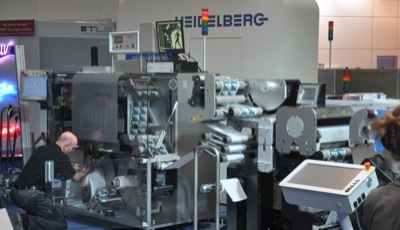 Changing the web on the Heidelberg LinoPrint L on the Gallus stand
Changing the web on the Heidelberg LinoPrint L on the Gallus stand

